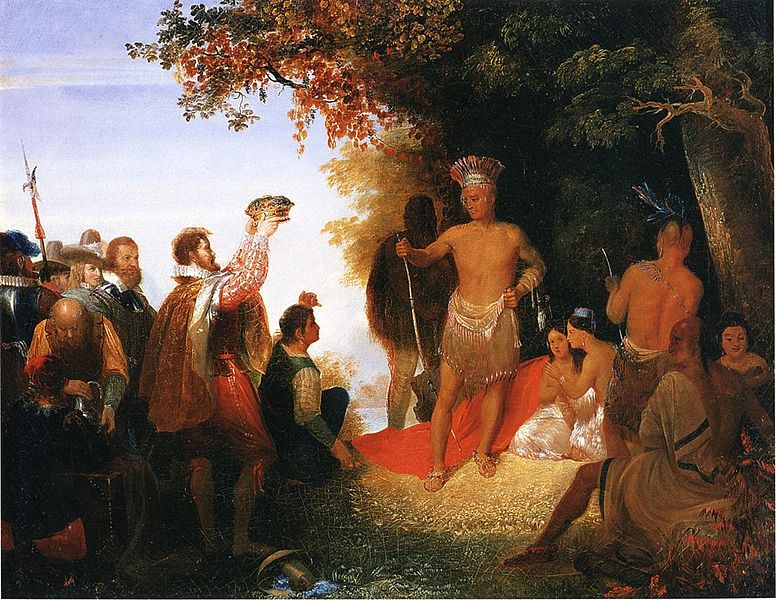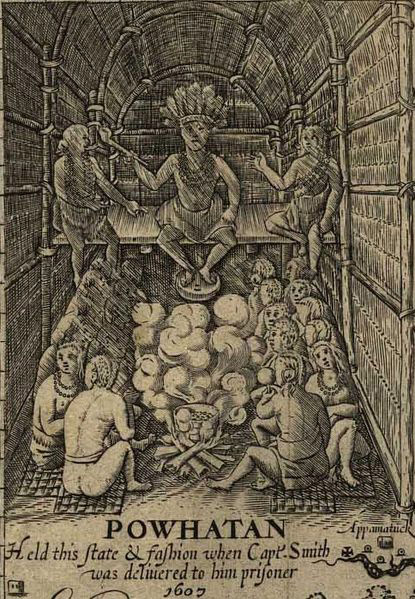 John Cabot was the first explorer to reach North America under the British flag in 1497, which was the beginning of England’s unstoppable interest in exploring the New World. But it would take almost 100 years before real, organized attempts at true colonization of America were mounted. An earlier colonizing attempt by a group from England attempted to establish a foothold on Roanoke Island near present-day North Carolina in 1587, only to meet with disaster. Some 107 people were delivered to Roanoke Island, but they vanished without a trace. Although no one knows what happened to the “Lost Colony”, a very likely suspect in their disappearance was a loose federation of tribes known collectively as the Powhatan.
John Cabot was the first explorer to reach North America under the British flag in 1497, which was the beginning of England’s unstoppable interest in exploring the New World. But it would take almost 100 years before real, organized attempts at true colonization of America were mounted. An earlier colonizing attempt by a group from England attempted to establish a foothold on Roanoke Island near present-day North Carolina in 1587, only to meet with disaster. Some 107 people were delivered to Roanoke Island, but they vanished without a trace. Although no one knows what happened to the “Lost Colony”, a very likely suspect in their disappearance was a loose federation of tribes known collectively as the Powhatan.
The first real settlement by the British in America is the Jamestown Settlement, established in 1607. It was led by Captain John Smith. The first series of ships that arrived contained only men and boys. Women would not arrive until a year later. These first seekers were on a reconnaissance mission, surveying in an attempt to determine a proper location for a first foothold. These first colonists faced immediate conflicts with the Native Americans – the bad blood between the Natives and the English probably was not unearned.
Early Confrontation
Before permanent colonists arrived, a number of ship captains confronted curious groups of Indians on exploratory journeys, and they committed a number of outrages. In one case, a certain ship Captain Hunt tricked 27 Indian men into coming board his ship. The Indians were immediately accosted, chained below, and shipped off to be sold as slaves in Spain. The kidnapping was witnessed by other Indians, and they spread the word far and wide about the hostile nature of these strange new visitors from across the sea.
John Smith’s Encounter
 By the time the Roanoke colony arrived, it was likely they were met with fear and distrust. A few years later when the Jamestown settlement arrived, John Smith eventually began to make inquiries about the Lost Colony. He spoke with the chief of the Powhatan, Wahunsenacawh, who said that his people had attacked and killed the people of the Roanoke colony, although there was reason to believe this story was not true.
By the time the Roanoke colony arrived, it was likely they were met with fear and distrust. A few years later when the Jamestown settlement arrived, John Smith eventually began to make inquiries about the Lost Colony. He spoke with the chief of the Powhatan, Wahunsenacawh, who said that his people had attacked and killed the people of the Roanoke colony, although there was reason to believe this story was not true.
Incidentally, Wahunsenacawh is more commonly referred to today as Chief Powhatan, which is somewhat of a misnomer since this was not his proper name. Rather Powhatan is the overarching identity of the federation of tribes that were under his rule. Chief Powhatan is also famous for being the father of Pocahontas, the Native American princess of much fame.
As the people of the Jamestown settlement continued their epic struggle to build a colony in America, hostilities with the Powhatan would soon become a major obstacle. That was not part of their plan. In fact, a major link in the strategy for the survival of Jamestown had actually been to establish friendly relationships with the Powhatan. The colonists were counting on trading with the Powhatan for food – and for a short period – there was a tentative agreement of sorts worked out, thanks in part to the historic intervention of the kindly Princess Pocahontas.
The relationship with the Powhatan Confederacy also hinged heavily on the superior diplomatic skills of John Smith, who was a gifted negotiator with the Indians.
Starving Time for the Colonists
Unfortunately, John Smith was severely injured in a gunpowder accident in 1609, forcing him to return to England that year. Upon his departure, relations with the Powhatan quickly broke down, and outright hostilities ensued. The Powhatan tribes implemented a strategy which has come to be known as the “Starving Time.” In effect, the Indians hemmed in the colonists, making it difficult for them to leave the confines of their settlement to hunt and gather food. The land area they had settled turned out to be extremely poor in both soil and wild game. It was a swampy area infested with mosquitoes and poor conditions for growing crops. The colonists were eventually forced to abandon the colony.
Powhatan Downfall
Despite this early success against the English by the Powhatan, it would prove to be the seed of their future destruction. The English were not done with Jamestown, and they made a third attempt to establish a new colony – this time better supplied, better prepared, better armed and ready to take the fight to the Indians.
The Powhatan launched major attacks against the colonists in 1622 and 1644. In both occasions, the colonists responded with a vengeance. The result was the devastation of the Powhatan Confederacy, which by the 1640 had come to be known collectively as the Powhatan Paramount Chiefdom.
It’s extremely important to keep in mind that historians warn us that thinking of the Powhatan as a “confederation” is somewhat misleading. The true structure of the Powhatan society was actually much more complex, and perhaps not as tightly organized in the way of we think of a modern confederation. There were at least 30 different distinct bands of Indians under the broad umbrella of the Powhatan alliance. Each local group had its own chief, called a weroance. No one knows for sure just how cooperative or beholden each weroance was to the central Powhatan power base represented in the person of Chief Wahunsenacawh, the man we somewhat erroneously today refer to as Chief Powhatan.
Whatever the case, the confrontations with the English colonists were devastating to these Native Americans. It is estimated that when the English arrived there were 14,000 to 21,000 people among the Powhatan. After their final major defeats in the 1640s, they were eventually scattered. The year 1646 is considered the year the Powhatan Confederacy became effectively nonexistent.
Today
But remnants of the Powhatan people still remain today. The state of Virginia recognizes eight distinct tribes of Powhatan. About 3,500 people today are enrolled in those tribes, although as many as three to four times that amount are eligible for identification as Powhatan. The original language of the Powhatan is now considered to be extinct, however.
Interestingly, the memory and identity of the Powhatan is being aided today by popular culture, mostly because of the enduring popularity of the most famous Powhatan of all – Princess Pocahontas, featured in a number of movies, especially in the animated Disney movie which bears her name. The unfortunate aspect of this is that the popular depictions of Pocahontas is more myth and folklore than reality, and does little to open a deeper doorway into or do justice to an ancient, vibrant, and proud culture.